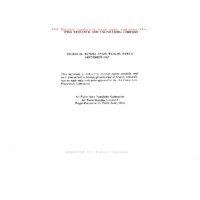-
Title
-
Lubricity Properties Of High-Temperature Jet Fuels
-
Date
-
1967
-
Index Abstract
-
Coming Soon
-
Photo Quality
-
Complete
-
Report Number
-
AFAPL TR 66-89 Part 2
-
Creator
-
Appeldoorn, J. K.
-
Tao, F. F.
-
Corporate Author
-
Esso Research And Engineering Co Linden Nj Products Research Div
-
Laboratory
-
Air Force Aero Propulsion Laboratory
-
Extent
-
164
-
NTRL Accession Number
-
AD821576
-
Identifier
-
AD0821576
-
Access Rights
-
Export Controls
-
Distribution Classification
-
1
-
Contract
-
AF 33(615)-2828
-
DoD Project
-
3048
-
DoD Task
-
304805
-
DTIC Record Exists
-
Yes
-
Distribution Change Authority Correspondence
-
AFAPL LTR
-
Distribution Conflict
-
No
-
Abstract
-
The study of the lubricity of jet fuels has been expanded to examine several new variables: hydrocarbon type, dissolved oxygen, dissolved water, higher temperatures, and metallurgy. Several important interactions have been found among these variables. The compounds most responsible for good lubricity are heavy aromaticsw. Removal of these materials during refining is the major cause of poor lubricity fuels. The heavy aromatics by themselves show unusual friction and wear behavior, giving low wear in air and scuffing in dry, inert atmospheres. Dissolved oxygen and water increase wear and friction by a corrosiion process. Corrosive wear appears to be the most serious cause of friction and wear problems of jet fuels. Nitrogen blanketing can eliminate wear completely in vane pump tests. Certain additives are effective only when water and air are present. A literature survey has been made of the effect of oxygen and water on lubrication. A methematical model of corrosive wear has been constructed and shows good agreement with experimental data. Higher temperatures give more wear and friction especially in air. However, oxidation of the fuel will form polar compounds that act as lubricity agents. Thisw reaction tends to mask the effect of temperature. Certain lubricity additives become much less effective at higher temperatures. Metals that resist corrosive wear, such as stainless steel, are better than chrome steel at low loads, but scuff more easily at higher loads. Future work will concentrate on higher temperatures and different metallurgies and the interaction of these variables with atmosphere and additive action.
-
Report Availability
-
Full text available
-
Date Issued
-
1967-09
-
Publisher
-
Wright-Patterson Air Force Base, OH : Air Force Aero Propulsion Laboratory, Air Force Systems Command
-
Provenance
-
Lockheed Martin Missiles & Fire Control
-
Type
-
report
-
Format
-
1 online resource
 AFAPLTR66-089part02.pdf
AFAPLTR66-089part02.pdf